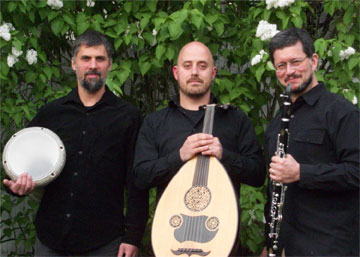Music from the Middle East

Music from the Arabian pennesulia has many influences, include that of the Greeks.
About: The music of Western Asia and North Africa spans across a vast region, from Morocco to Afghanistan, and its influences can be felt even further afield. Middle Eastern music influenced (and has been influenced by) the music of Greece and India, as well as Central Asia, Spain, Southern Italy, the Caucasus and the Balkans, as in chalga. The various nations of the region include the Arabic-speaking countries of the Middle East and North Africa, the Iraqi traditions of Mesopotamia, Iranian traditions of Persia, the varied traditions of Cypriot music, the music of Turkey, traditional Assyrian music, various Jewish traditions, Kurdish music, Berbers of North Africa, and Coptic Christians in Egypt all maintain their own traditions.
Throughout the region, religion has been a common factor in uniting peoples of different languages, cultures and nations. The predominance of Islam allowed a great deal of Arabic influence to spread through the region rapidly from the 7th century onward. The Arabic scale is strongly melodic, based around various maqamat (sing. maqam) or modes (also known as makam in Turkish music). This is similar to the dastgah of Persian music. While this originates with classical music, the modal system has filtered down into folk, liturgical and even popular music, with influence from the West. Unlike much western music, Arabic music includes quarter tones halfway between notes, often through the use of stringed instruments (like the oud) or the human voice. Further distinguishing characteristics of Middle Eastern and North African music include very complex rhythmic structures, generally tense vocal tone, and a homophonic texture.
Often, more traditional Middle Eastern music can last from one to three hours in length, building up to anxiously awaited, and much applauded climaxes, or tarab, derived from the Arabic term طرب tarraba.1
Similarities to other music styles: Middle Eastern musicians frequently perform taqasim – the art of improvisation. Taqasim may be woven into existing compositions – similar to a guitar riff in the middle of an American rock song – or played as an art in themselves, as in the Arabic classical tradition. The musician begins with a well-known melody, a maqam, or a simple collection of notes, then embellishes it in a free-flowing manner.2
Influences:Arabic music or Arab music (Arabic:الموسيقى العربية; Al-Mūsīqā Al-Arabīyya) is the music of the Arab World, including several genres and styles of music ranging from Arabic classical to Arabic pop music and from secular to sacred music.
Arabic music, while independent and very alive, has a long history of interaction with many other regional musical styles and genres. It is an amalgam of the music of the Arabs in the Arabian Peninsula and the music of all the peoples that make up the Arab World today. As was the case in other artistic and scientific fields, Arabs translated and developed Greek texts and works of music and mastered the musical theory of the Greeks (i.e. Systema ametabolon, enharmonium, chromatikon, diatonon).3
DISCOVER MORE
From Encyclopedia Britannica:
Middle Eastern music, music of the Arabic-, Turkish-, and Persian-speaking world. Despite three major languages and associated cultural differences, the music can be seen as a single great tradition because of the unifying element of Islam. The fact that Islam has historically found music problematic has resulted in relatively little religious ceremonial music, but it has not held back secular music and has even enriched it with a strong religious strain. Only those following certain practices, such as Sufism, have used music (and dance) for worship; within the mosque, however, activities resembling music (but which are not considered music per se) generally have been limited to the call to prayer (adhān) and the chanting of the Qurʾān.
Folk music and art music differ less in the Middle East than elsewhere, especially because folk music, like art music, has long been the province of professionals (including many women), and the two traditions are based largely on similar principles. Both tend to feature soloists, either alone or accompanied by a small group. Rhythmic treatment also is similar, being closely related to principles of prosody but also employing rhythmic modes called īqāʿāt in Arabic. Both types of music also include characteristic nonmetric improvisations. The melodic and tonal construction of performances, which is based on a system of modes called maqām in Arabic, also is the same in folk and art-music traditions.
A typical performance consists of alternating sections of composed and improvised material, the composed portions being accompanied by percussion instruments beating one of a number of standard patterns that articulate the rhythmic mode. Melodic instruments—such as the nāy (flute), zornā (double-reed instrument), ʿūd (short-necked lute), and sanṭūr (trapezoidal zither)—play in unison with the solo line during the composed parts and echo it one or two beats behind in the improvised parts. Especially after 1950, the rise of Western-influenced commercial popular music affected Middle Eastern art music, which now employs less improvisation and more strict unison between parts, in shorter pieces. The Middle East has been an important source of musical instruments for other parts of the world. Bagpipes, guitar, lute, oboe, tambourine, viols, and most zithers have a Middle Eastern origin.4
VIDEOS
Arab middle east classical guitar
Arab middle east classical guitar Version 2
A video to show the similarities of all Middle Eastern Music
Source:
1.Middle Eastern Music, Wikipedia http://en.wikipedia.org/wiki/Middle_Eastern_music
2.About, Jawaahir Dance Co. http://www.jawaahir.org/AboutTheDance,AboutTheMusic.htm
3. Arabic Music, Wikipedia http://en.wikipedia.org/wiki/Arabic_music
4. Middle Eastern music (2011). In Encyclopædia Britannica, Inc. Retrieved August 2, 2011, from Encyclopedia Britannica Online: http://www.britannica.com/EBchecked/topic/719111/Middle-Eastern-music









